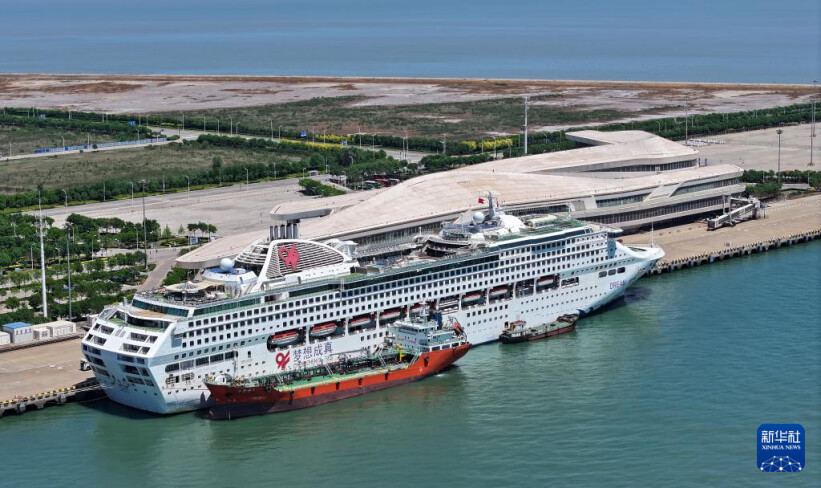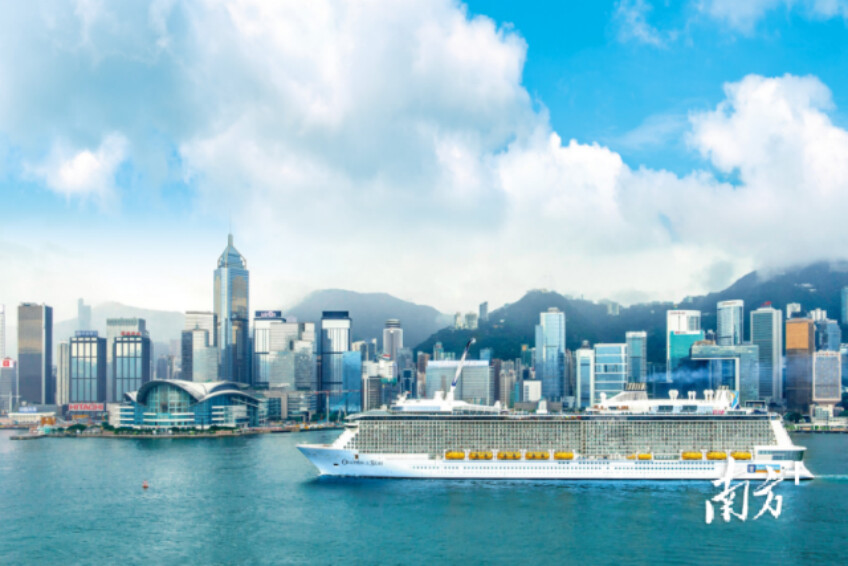(Continued from "Guangdong's two cruise ship home ports ready to seize opportunities")
The cruise industry economy includes not only the leisure and entertainment consumption of cruise tourists on board, but also the onshore consumption of cruise tourists and cruise crew. Additionally, for the city where the home port is located, how to attract foreign tourists to go ashore for sightseeing and consumption when the cruise ship enters the country is key.
Data from the International Association of Cruise Enterprises shows that in 2019, the onshore consumption of cruise tourists in home ports around the world amounted to 11.44 billion U.S. dollars, the onshore consumption of cruise tourists in visiting ports amounted to 9.56 billion U.S. dollars, and the onshore consumption of cruise crew members amounted to 1.43 billion U.S. dollars.

Tianjin International Cruise Home Port (Photo: Xinhua)
In the same year, Shanghai's cruise homeport received 45.5% of the total number of cruise tourists in China, and the onshore consumption of cruise tourists was 985 million yuan. However, the onshore consumption of cruise tourists visiting the port was only 0.28 billion yuan.
Thus, how to attract international tourists to come ashore for consumption is still a topic that needs to be studied by domestic homeport cities.
Yao Qiaoling, who has been engaged in the cruise business for many years, believes that customers who travel by cruise ship are highly planned, and their itineraries are grouped into different packages, rarely making temporary changes.
And in the view of Ken Guan, spokesman of GZL International Travel Service Ltd., since the cruise ship itself advocates that it is a tourist destination in its own right, cruise lines will offer shore excursions as an option to passengers. However, not everyone will choose to go ashore. "Local travel agencies in home ports usually design some one-day tour products around the characteristics of shore excursions to offer to cruise lines."
It is evident that it is crucial to enhance the core attractiveness of the cruise inbound tourism product.
Because of the complex relationship between competition and cooperation in cruise tourism and home port city tourism, the form of cruise tourism is affected. For cruise companies, whether the city of call has tourist attraction will affect the attractiveness of the cruise line. Additionally, the development of cruise tourism and the home port city tourism will also have a role in promoting.
From a global perspective, the world's famous cruise tourism cities are vigorously promoting the integrated development of city tourism and cruise homeports. They are making comprehensive efforts in terms of the city's macro-planning, micro-design, tourism functions, as well as complementary tourism products.
At present, there are many domestic homeports that apply the visa-free policy for cruise ships, and Guangdong's cruise homeports should combine the local advantages so that the cruise homeports and city tourism can realize closer integration and highlight their own characteristics. This will attract more cooperation and routes from cruise companies.
Huang Juan, an associate researcher at the China Tourism Research Institute, believes that Shanghai, Tianjin, Xiamen, Guangzhou, Shenzhen, Qingdao and other cruise port cities are important coastal tourism cities. In the context of implementing the policy of visa-free entry for foreign tour groups on cruise ships, these cities should promote the "integration of port and city" to enhance the attractiveness of cruise inbound tourism. The goal should be to upgrade from "cruise terminal" to "cruise port" and ultimately to "cruise city".
According to Huang Juan, cruise ports should build a cooperative relationship with each other instead of operating independently. They should establish a cruise port system with a reasonable layout, scale, structure, and function.
Currently, there are three major cruise homeports in the Guangdong-Hong Kong-Macao Greater Bay Area: Guangzhou, Shenzhen, and Hong Kong. These ports can explore forming a cooperative relationship with each other to create a diverse system of on-shore tourism products and attractive cruise itineraries. This will cater to the demand for departures from different sources of passengers and the desire for on-shore tourism.

Ovation of the Seas owned by Royal Caribbean International (RCI) docks at Hong Kong Homeport (Photo: Nanfang Plus)
At the government level, Guangdong can introduce relevant policies to support cruise tourism. Last year, cities like Shanghai and Tianjin issued policies like the "Shanghai Action Program for Promoting the High-Quality Development of International Cruise Economy (2023-2025)" and "Tianjin Municipal Implementing Rules to Encourage the Development of Cruise Tourism" to boost the cruise industry and support tourism enterprises.
Author | Gong Mingyang, Dai Xiaoxiao, Zhang Yating
Editor | He Shan, Monica, James
















